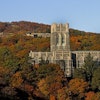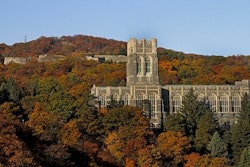Dillard University and All That Jazz
New Orleans-based HBCU seeks to set itself apart with creation of new jazz institute, orchestra
By Kendra Hamilton
The notion simply didn’t compute: New Orleans — the birthplace of jazz; producer of jazz greats from Sidney Bechet and Louis Armstrong to the Marsalis clan; perhaps the only city in America where jazz remains a living cradle-to-grave experience and form of expression — does not have a jazz orchestra.
At least it didn’t compute to Dillard University president Dr. Michael Lomax or to Irvin Mayfield, the 25-year-old trumpet wunderkind who has been artist-in-residence at the New Orleans-based historically Black college since September. But fortunately, the pair was in a position to do something about it.
In late December, Dillard announced the creation of the New Orleans Jazz Orchestra (NOJO), a 21-person unit with a concert season, a salaried roster of musicians, a resident conductor and a board to manage the orchestra and solicit corporate donations. Even more importantly, NOJO will be the performing arm of Dillard’s Institute of Jazz Culture, an interdisciplinary academic program bringing together music, sociology, political science and related subjects under one umbrella established last fall.
Dr. Michael White, the Keller Chair of the Humanities at Xavier University, also based in New Orleans, is enthusiastic about the institute’s potential.
“This institute threatens to give (the New Orleans jazz community) the class and connection of (New York’s) Lincoln Center, but with the advantage that it’s located here,” said White in an interview with Black Issues.
“There’s a much wider range of jazz styles still being performed here in New Orleans from the oldest and the most traditional to the most contemporary. That’s a great thing for the institute,” White explained.
The jazz orchestra and institute are in many ways a dream come true for Lomax, whose lifelong commitment to the arts was forged as founding chair of the National Black Arts Festival. He also sits on the boards of world-class arts organizations such as the Studio Museum in Harlem, Atlanta’s Alliance Theater, the Smithsonian’s National Museum of African Art and many others.
“Part of my dream for this institution has been to lay the groundwork for renaissance in the arts here,” Lomax says. “We’ve been working, working very hard, over the last five years to put ourselves on a firm footing in other areas. And we’ve worked so effectively that one of the things we’ve started thinking about is how to differentiate ourselves from the many other educational institutions in this area. One thing about New Orleans is that you don’t think about this area without thinking about music.”
And if Lomax and Mayfield — a Billboard and Downbeat award winner and Grammy nominee — have their way, one soon won’t be able to think about music in New Orleans without thinking about Dillard.
The school has provided $100,000 in seed money to get the institute rolling, and it has identified $1 million in fund-raising prospects, with $300,000 in “asks” in the works, Lomax says. Response from the corporate community has been surprisingly robust. And Mayfield thinks he knows why.
“I think we really have the answer as far as jazz (education) is concerned,” Mayfield says. He admits that there are other acclaimed jazz programs in the area — specifically at Loyola University, Southern University and University of New Orleans, where acclaimed Dillard alumnus Ellis Marsalis created and ran the jazz program for 12 years before his recent retirement.
“In those other places that have music programs, only students who are music majors can participate,” Mayfield says. “That is not our approach. The entire university and even the New Orleans community can interact with our program because we’re looking at establishing jazz as an institution and using that basis to explore jazz photography, jazz and the visual arts, jazz and history.
“We’re looking at using jazz to stimulate undergraduate research,” Mayfield continues. “There’s a lot of work to be done — for example, on jazz families (i.e., musical family lineages in New Orleans). The manifestations are endless.”
There are those, of course, who resist the whole notion of jazz entering mainstream educational institutions. Indeed, as jazz has gained in acceptance and jazz education has become a worldwide phenomenon with highly regarded programs at places such as North Texas State and Indiana universities, critics have claimed that such programs lack legitimacy, that jazz only can be transmitted from individual artist to individual artist in a master-apprentice relationship.
But Mayfield disagrees. “There’s too much separation between people and what belongs to them. That’s why we want jazz as part of our core curriculum.”
Those sentiments are echoed by jazz master Ellis Marsalis, who has lent his name to the NOJO advisory board and who will be performing in the first concert of its series, a Valentine’s Day “Love in Jazz” concert with Marsalis and Mayfield as featured soloists.
Jazz, Marsalis maintains, needs structure in order to survive.
“It reminds me of a club I used to go to in Richmond when I was teaching at Virginia Commonwealth (University),” Marsalis recalls. “It was a wonderful club — it was getting a name, good people were performing there and the crowds were good, too. But whoever owned it sold the building, and it all just disappeared.
“It’s a similar situation with jazz,” Marsalis says. “It’s not a thing unto itself — music doesn’t mean anything unless it’s being played for somebody — so consequently, what is really needed is a kind of infrastructure, what I like to call a top end.”
White is another advocate of structure. As a city, he notes, New Orleans “is blessed with talent. But to have people who can perform is only one piece. We also need support personnel — attorneys, booking agents, people to run music stores, to make and repair instruments.
“Not everyone who goes through the institute will become a performing jazz musician. It’s my hope the institute can provide the holistic approach that will make New Orleans respected as a player” in the music industry, White says.
“What’s needed is education,” Marsalis says. “Period. Across the board.”
The structure of Dillard’s program should be very conducive to providing that education, according to Mayfield. For example, he says that instead of a single artist-in-residence — the common structure in arts education for encouraging student contact with successful practitioners — the existence of the orchestra provides, in effect, 21 artists-in-residence to mentor and advise students.
Plans also include a lecture series that will strengthen the connection among Dillard, its students and its host community. Mayfield is working furiously to schedule lectures by White, who writes on the history and culture of the city’s “second line” dancers; Herman Leonard, the world-renowned jazz photographer; and by Stanley Crouch, MacArthur-winning jazz and cultural critic.
And if that’s not enough, Mayfield also is putting the final touches on the work that will be the centerpiece of NOJO’s second spring concert: “Strange Fruit,” an original suite for the jazz orchestra and the Dillard concert choir commissioned by Lomax. Lomax and Mayfield had traveled to Atlanta’s Martin Luther King Center to see “Without Sanctuary,” an acclaimed exhibit of lynching postcards. “The images were so small — so intimate,” Lomax notes, “but so powerful.”
And Mayfield felt the same powerful inspiration from Lomax’s desire “to get the whole community engaged in dialogue.” With a live broadcast from New Orleans’ legendary jazz and blues station, WWOZ, the school seems poised to get the whole town talking.
© Copyright 2005 by DiverseEducation.com


















